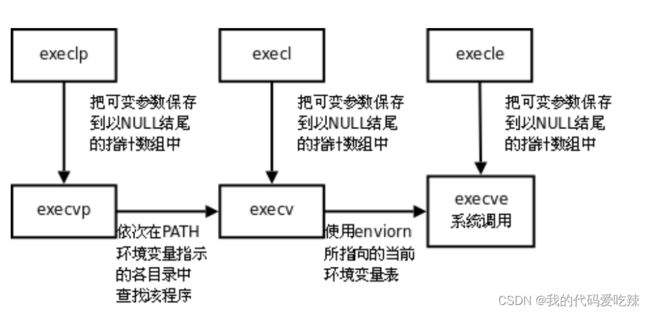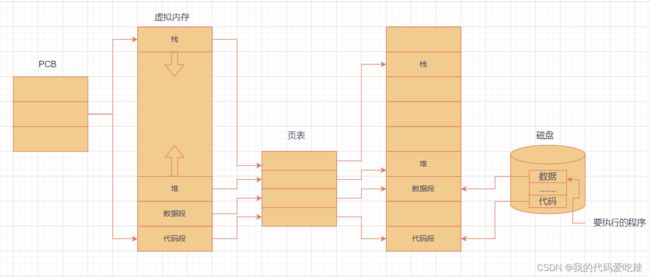进程程序替换
✅<1>主页::我的代码爱吃辣
<2>知识讲解:Linux——进程替换
☂️<3>开发环境:Centos7
<4>前言:我们创建子进程的目的是什么?想让子进程帮我们执行特定的任务。那么如何让子进程去执行一段新的代码呢?
一.背景
二.子进程程序替换
三.替换函数
1.execv
2.execlp
3.execle
4.命名理解
四.实现minishell
一.背景
我们创建子进程的目的是什么?想让子进程帮我们执行特定的任务。
1.让子进程执行父进程的一部分代码
2.如果子进程指向一个全新的代码呢?这就是进程的程序替换。
见一见单进程版本进程替换,即父进程指向一个全新的代码:
隆重介绍一个接口:
int execl(const char *path, const char *arg, ...);- path:替换程序的路径。
- arg:如何执行该程序。
- 可变参数:如何执行该程序的参数等。
测试代码:
#include
#include
int main()
{
printf("--------------------begin-------------\n");
execl("/usr/bin/ls", "ls", "-a", "-l", NULL);
printf("--------------------end---------------\n");
return 0;
} 注意:
- 我们想替换的程序 "ls -a -l"。
- ls 的路径:/usr/bin/ls。
- "-a" "-l" 时ls命令的参数。
- 最后结束要以NULL结尾。
测试结果:
注意:
- 进程替换以后我们,并没有看到我们源代码里面的最后一个打印。
- 原因是程序在替换以后,在后续执行完ls的代码就会退出了,不会回到execl调用后面。
二.子进程程序替换
创建好子进程,让子进程调用execl,让子进程去执行替换的程序。
用fork创建子进程后执行的是和父进程相同的程序(但有可能执行不同的代码分支),子进程往往要调用一种exec函数以执行另一个程序。当进程调用一种exec函数时,该进程的用户空间代码和数据完全被新程序替换,从新程序的启动例程开始执行。调用exec并不创建新进程,所以调用exec前后该进程的id并未改变。
测试代码:
#include
#include
#include
#include
int main()
{
int status;
printf("--------------------begin-------------\n");
pid_t pid = fork();
if (pid == 0)
{
// 我们想替换的程序 "ls -a -l"
// ls 的路径:/usr/bin/ls
//"-a" "-l" 时ls命令的参数
// 最后结束要以NULL结尾
execl("/usr/bin/ls", "ls", "-a", "-l", NULL);
}
waitpid(-1, &status, 0);//阻塞等待子进程退出。
if (WIFEXITED(status))
printf("子进程退出,退出码:%d\n", WEXITSTATUS(status));
else
printf("子进程异常,收到信号%d\n", status & 0x7F);
printf("--------------------end---------------\n");
return 0;
} 测试结果:
进程替换原理:
当进程调用一种exec函数时,该进程的用户空间代码和数据完全被新程序替换,从新程序的启动
例程开始执行。调用exec并不创建新进程,所以调用exec前后该进程的id并未改变。
三.替换函数
其实有六种以exec开头的函数,统称exec函数:
#include
int execl(const char *path, const char *arg, ...);
int execlp(const char *file, const char *arg, ...);
int execle(const char *path, const char *arg, ...,char *const envp[]);
int execv(const char *path, char *const argv[]);
int execvp(const char *file, char *const argv[]); int execve(const char *path, char *const argv[], char *const envp[]);函数解释:
- 这些函数如果调用成功则加载新的程序从启动代码开始执行,不再返回。
- 如果调用出错则返回-1。
- 所以exec函数只有出错的返回值而没有成功的返回值。
介绍其中几个:
1.execv
int execv(const char *path, char *const argv[]);- path:程序所在的路径,
- argv:是一个指针数组,数组每一个元素代表我们需要怎么执行程序。
测试代码:
#include
#include
#include
#include
int main()
{
int status;
printf("--------------------begin-------------\n");
pid_t pid = fork();
if (pid == 0)
{
// 我们想替换的程序 "ls -a -l"
// ls 的路径:/usr/bin/ls
//"-a" "-l" 时ls命令的参数
// 最后结束要以NULL结尾
char *argv[] = {"ls", "-a", "-l", NULL};
execv("/usr/bin/ls", argv);
}
waitpid(-1, &status, 0);
if (WIFEXITED(status))
printf("子进程退出,退出码:%d\n", WEXITSTATUS(status));
else
printf("子进程异常,收到信号%d\n", status & 0x7F);
printf("--------------------end---------------\n");
return 0;
} 测试结果:
2.execlp
int execlp(const char *file, const char *arg, ...);- file:程序名称。
- 后续参数:需要怎么执行程序。
- 不需要给出程序路径,execlp会自己到环境变量中找对应的程序。
测试代码:
#include
#include
#include
#include
int main()
{
int status;
printf("--------------------begin-------------\n");
pid_t pid = fork();
if (pid == 0)
{
// 我们想替换的程序 "ls -a -l"
// ls 的路径:/usr/bin/ls
//"-a" "-l" 时ls命令的参数
// 最后结束要以NULL结尾
execlp("ls", "ls", "-a", "-l", NULL);
}
waitpid(-1, &status, 0);
if (WIFEXITED(status))
printf("子进程退出,退出码:%d\n", WEXITSTATUS(status));
else
printf("子进程异常,收到信号%d\n", status & 0x7F);
printf("--------------------end---------------\n");
return 0;
}
测试结果:
3.execle
int execle(const char *path, const char *arg, ...,char *const envp[]);- path:程序路径。
- envp:是一个指针数组,用来传输环境变量。
- arg:我们如何执行程序。
测试代码:
#include
#include
#include
#include
int main()
{
extern char **environ;
int status;
printf("--------------------begin-------------\n");
pid_t pid = fork();
if (pid == 0)
{
// 我们想替换的程序 "ls -a -l"
// ls 的路径:/usr/bin/ls
//"-a" "-l" 时ls命令的参数
// 最后结束要以NULL结尾
execle("./newdir/otherproc", "otherproc", NULL, environ);
}
waitpid(-1, &status, 0);
if (WIFEXITED(status))
printf("子进程退出,退出码:%d\n", WEXITSTATUS(status));
else
printf("子进程异常,收到信号%d\n", status & 0x7F);
printf("--------------------end---------------\n");
return 0;
} newdir/otherproc.cc
#include
#include
#include
using namespace std;
int main()
{
cout << "hello world"
<< "hello:" << getenv("hello") << endl;
cout << "hello world"
<< "hello:" << getenv("hello") << endl;
cout << "hello world"
<< "hello:" << getenv("hello") << endl;
return 0;
} 测试结果:
4.命名理解
这些函数原型看起来很容易混,但只要掌握了规律就很好记。
- l(list) : 表示参数采用列表
- v(vector) : 参数用数组
- p(path) : 有p自动搜索环境变量PATH
- e(env) : 表示自己维护环境变量
exec调用总结:
#include
int main()
{
char *const argv[] = {"ps", "-ef", NULL};
char *const envp[] = {"PATH=/bin:/usr/bin", "TERM=console", NULL};
execl("/bin/ps", "ps", "-ef", NULL);
// 带p的,可以使用环境变量PATH,无需写全路径
execlp("ps", "ps", "-ef", NULL);
// 带e的,需要自己组装环境变量
execle("ps", "ps", "-ef", NULL, envp);
execv("/bin/ps", argv);
// 带p的,可以使用环境变量PATH,无需写全路径
execvp("ps", argv);
// 带e的,需要自己组装环境变量
execve("/bin/ps", argv, envp);
exit(0);
} 事实上,只有execve是真正的系统调用,其它五个函数最终都调用 execve,所以execve在man手册 第2节,其它函数在man手册第3节。这些函数之间的关系如下图所示。
四.实现minishell
用下图的时间轴来表示事件的发生次序。其中时间从左向右。shell由标识为sh的方块代表,它随着时间的流逝从左向右移动。shell从用户读入字符串"ls"。shell建立一个新的进程,然后在那个进程中运行ls程序并等待那个进程结束。
然后shell读取新的一行输入,建立一个新的进程,在这个进程中运行程序 并等待这个进程结束。
所以要写一个shell,需要循环以下过程:
1. 获取命令行
2. 解析命令行
3. 建立一个子进程(fork)
4. 替换子进程(execvp
代码:
#include
#include
#include
#include
#include
#include
#include
#define SEP " "
#define MAX 1024
#define MAX_SUB 64
// 分割命令"ls -a -l" --> "ls","-a" "-l"
void split(char buff[], char *subbuff[])
{
assert(buff);
assert(subbuff);
int i = 0;
subbuff[i++] = strtok(buff, SEP);
while (subbuff[i++] = strtok(NULL, SEP)) // 如果没有找到分割,就会返回NULL
;
}
// 代码测定,打印命令
void debug(char *subbuff[])
{
int i = 0;
while (subbuff[i])
{
printf("%s\n", subbuff[i++]);
}
}
// 显示环境变量
void showenv()
{
extern char **environ;
for (int i = 0; environ[i]; i++)
{
printf("[%d]:%s\n", i, environ[i]);
}
}
int main()
{
int status = 0; // 退出码参数
char myenv[32][512] = {0}; // 用户自定义环境变量
int index_env = 0;
int last_exit = 0;
while (1)
{
char buff[MAX] = {0}; // 存储命令行输入的命令字符串
char *subbuff[MAX_SUB] = {NULL};
printf("wq@[aliyum]$:");
fflush(stdout);
// 1.获得命令字符串
fgets(buff, sizeof(buff), stdin);
// 2.解析命令
// ls -a -l\n\0,strlen=9,index(\n)=8,去除回车。
buff[strlen(buff) - 1] = '\0';
// 分割字符串
split(buff, subbuff);
// 处理内建命令
// 注意:cd,export,env,echo,等命令都是内建命令,即这些命令不能创建子进程执行,只能bash自己执行
if (strcmp(subbuff[0], "cd") == 0)
{
if (subbuff[1] != NULL)
chdir(subbuff[1]);
continue;
}
else if (strcmp(subbuff[0], "export") == 0)
{
if (subbuff[1] != NULL)
{
// 这里不能将subbuff[1]直接导入环境变量,因为环境变量表存储的都是指针,必须使用一个单独空间
strcpy(myenv[index_env], subbuff[1]);
putenv(myenv[index_env++]);
}
continue;
}
else if (strcmp(subbuff[0], "env") == 0)
{
showenv();
continue;
}
else if (strcmp(subbuff[0], "echo") == 0)
{
// echo $PATH
if (subbuff[1][0] == '$')
{
if (subbuff[1][1] == '?') // echo $?//最近一次推出吗
{
printf("%d\n", last_exit);
}
else // 提取环境变量
{
// PATH
char *subenv = subbuff[1] + 1;
char *get_env = getenv(subenv);
if (get_env != NULL)
{
printf("%s=%s\n", subenv, get_env);
}
}
}
continue;
}
if (strcmp(subbuff[0], "ls") == 0)
{
int comm_index = 0;
while (subbuff[comm_index])
{
comm_index++;
}
// 增加高亮
subbuff[comm_index] = "--color=auto";
}
// 3.创建子进程
pid_t pid = fork();
assert(pid >= 0);
if (pid == 0) // 子进程
{
extern char **environ;
// 4. 程序替换
execve(subbuff[0], subbuff, environ);
}
// // 测试
// debug(subbuff);
waitpid(pid, &status, 0);
if (WIFEXITED(status))
{
// 子进程退出设置退出码
last_exit = WEXITSTATUS(status);
}
}
return 0;
}








